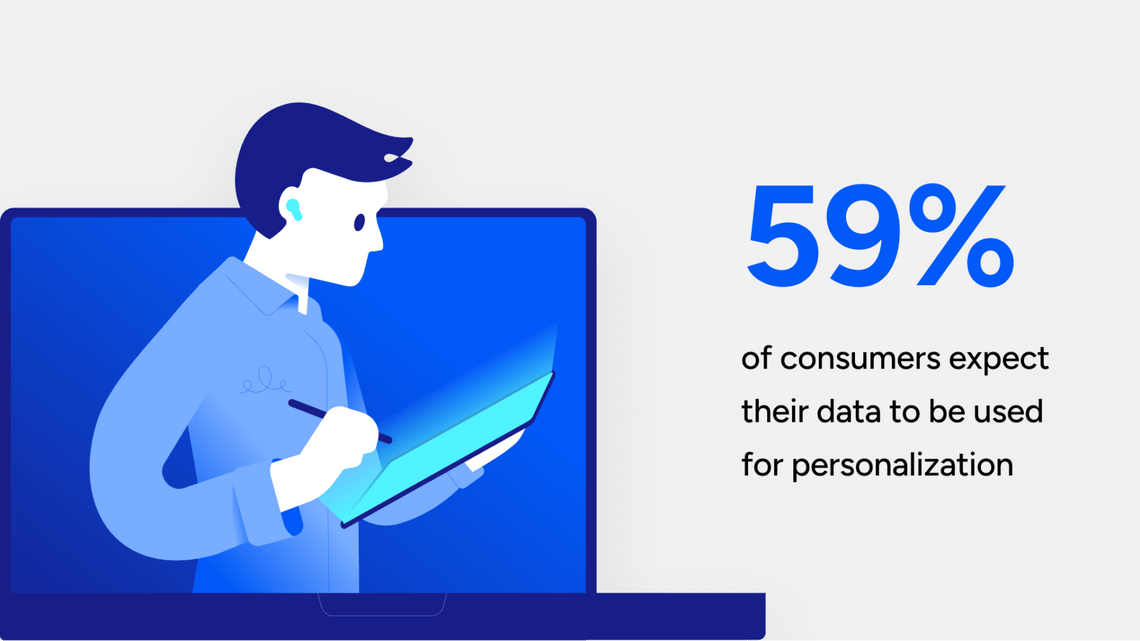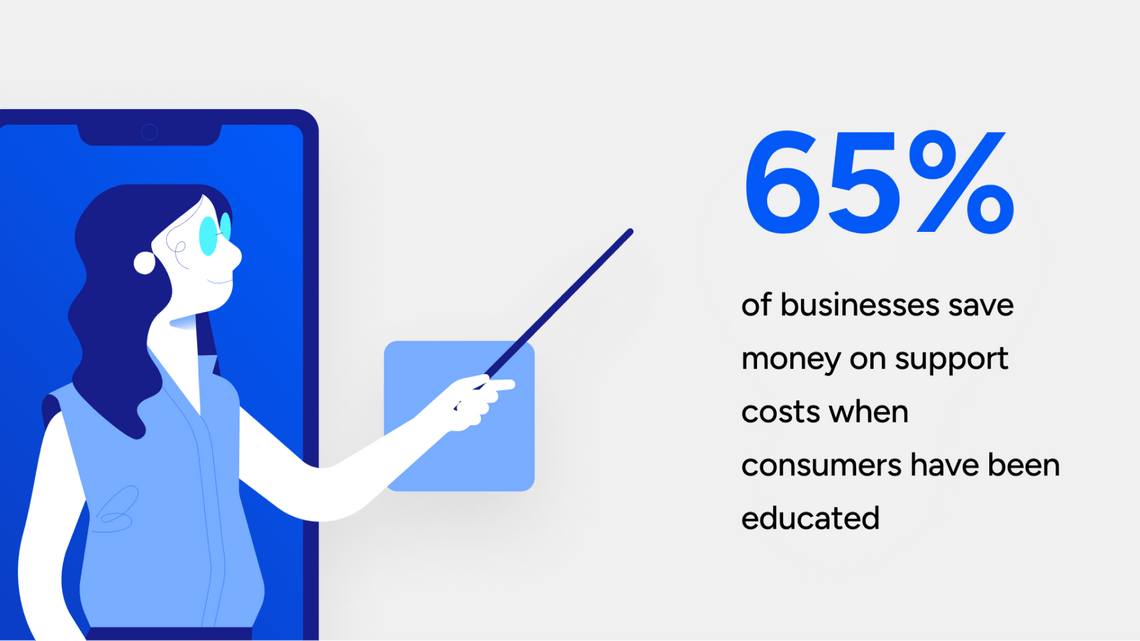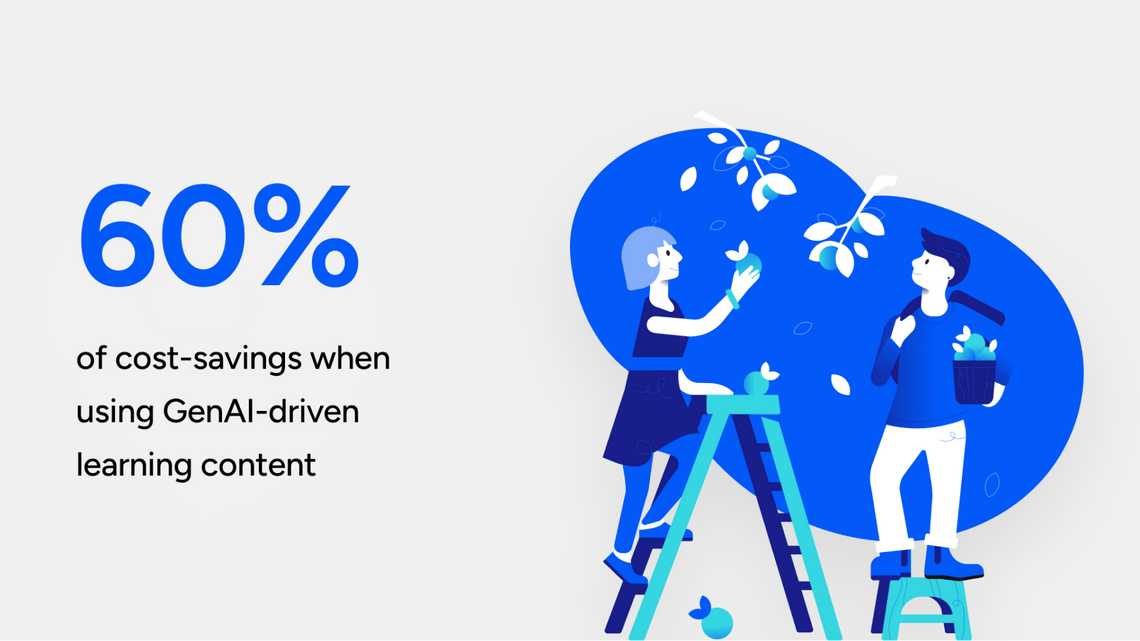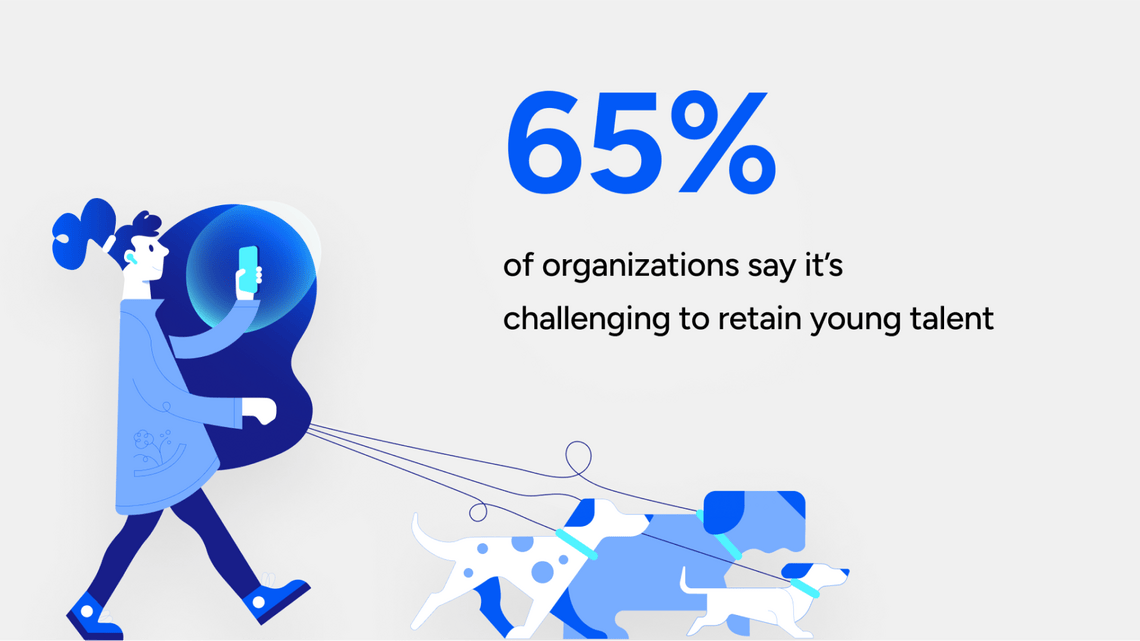The definitive guide to mastering L&D in Banking and Finance
It’s more important than ever for financial institutions to learn and adapt quickly if they want to stay relevant. But in 2022, only 10% of worldwide banks were able to successfully address customer digitalization demands.
In order to adapt to a rapidly evolving financial landscape that includes competitors like fintechs and even unexpected entrants like WalMart,[1] banks need to secure the right tech talent, and/or partners, while enabling robust cybersecurity.
So how can learning leaders in banking stay ahead of the curve?
One thing is clear: these challenges cannot be met head-on without a learning culture that reaches wide into the workforce, customer base, and partner ecosystem.
Let’s dive into some challenges facing this dynamic industry, and what strategic learning solutions will prove vital to address them. But first…
What is L&D in banking and finance?
Learning and development in banking and finance should go beyond compliance training to meeting the industry needs for customer education, and upskilling and fostering the right talent.
As we will see soon when we address the challenges faced by banking and finance industries, the ideal L&D program in banking and finance should be an integrated learning ecosystem of learners, customers, and partners.
Why integrated? L&D programs should be interconnected to reap the benefits of efficiency and scalability, enabling training of multiple audiences and distributing according to need.
Think of the ideal L&D program as a Centre of Excellence, where L&D programs are hosted on a centralized learning platform, capable of tech consolidation to trim the fat from outdated siloed systems.
L&D programs should focus on audience performance and business outcomes. For instance, 59% of consumers expect their data to be used for personalization, and 62% say they would be less likely to interact with a company if it failed to provide personalized information or responses.
L&D programs should prioritize learning journeys, leveraging data analytics to align with business goals. As digital transformation continues to be crucial for banking institutions, L&D programs must also embrace AI.
Now let’s dive into some of the challenges affecting banking and finance and address potential solutions.

What are the Challenges of Building Successful L&D Programs for Banking and Financial Services?
#1. Meeting Increasing Customer Expectations
Challenge: Customers demand banks care about them, and others.
Today’s customers are tech savvy and socially conscious. Take for instance the rise in purpose-driven banking, the idea that a banking institution should be focused on the people it provides services for rather than the profits it makes.
Socially conscious banking has climbed steadily in popularity since the housing crisis of 2008, with 76% of bank executives now believing that their sectors are obligated to address societal issues.
Customers also now demand on-the-go, personalized, seamless experiences that feel tailored to their needs, requiring banks to step up in digitalization.
Learning solution: Set up customer education programs centered on seamless and personalized experiences.
Digital currency, investments, and other banking info can be complex for the average consumer.
This is where customer education comes in.
Customer education empowers the consumer with the right financial choices and fosters trust, which is important given that only 54% of the population trusts financial institutions, as reported by Economist Impact.
By embedding learning content into your services to educate clients, you will foster customer engagement and service adoption.
Being able to access financial knowledge anywhere, safely, from any device will prove to be the cherry on top of customer education, as users will stay due to convenience.
If you’re still unsure, educational content tailored to customers makes them 131% (131%!) more likely to buy, and 65% of business respondents report they save money on support costs when consumers have been educated (Skilljar 2022 survey).


#2. Embracing the Digital Revolution
Challenge: Keeping up with the AI revolution.
AI is rapidly changing how we work, and that’s because most of us have already adopted it.
75% of global “knowledge workers” (mostly office workers like project managers, writers, accountants, architects, and more) currently use AI in their day-to-day work.
It makes sense then that digital transformation is no longer a future checklist item, but rather a mid-term strategic priority for many banks.
Learning solution: Embrace a platform trained with AI.
Choosing a Learning Platform that is trained with AI will give you an edge, as it can be used to generate upskilling training programs quickly, which will allow you to develop and retain talent.
AI is projected to generate content three times faster, leading to 60% in cost-savings while delivering high-quality L&D content, and reducing the time required to create a sample course.
With AI-driven learning platforms like Docebo’s, you would have access to powerful AI authoring tools and regularly updated industry-leading content.

AI-backed Learning Platforms like Docebo’s can also allow you to gain insight through data integration between Learning metrics and your own indicators, enabling you to better understand your teams’ performance.
Organizations that create new KPIs using AI are three times more effective at predicting future performance, three times more likely to see financial gains, and twice more efficient, as detailed by the MITSloan Review.
With engaging communities to elevate learning experiences, you can also ensure your team feels supported and prepared to deal with AI challenges, rather than rolling with the punches.
#3. Staying ahead of the competition
Challenge: Competing Fintech firms, and modernizing legacy systems.
Fintech firms and open banking institutions have successfully leveraged digitalization to make it easier for clients to access and transfer their funds from anywhere safely.
Digital currencies are also gaining traction by stabilizing, meaning new demands from customers, and new business opportunities for banks.
As banks begin addressing these competitive challenges by modernizing their business models, they may absorb fintech companies, or begin to hire third parties that can offer the tech-edge value that fintech companies already offer.
But this in turn requires both educated customers and employees.
Learning solution: Develop programs that upskill your teams with built-in workflows that will allow you to collect relevant data.
FintechOS, a high-tech company that builds data-driven, scalable, and customer-centric financial products for banks, financial institutions and insurers, chose Docebo’s AI-driven Learning Platform.
In just 9 weeks, they were able to launch a world-class learning global program with over 400 registered users, each completing 5-7 courses.
Meaning? They had high enrollment and engagement in little time allowing them to capitalize on the momentum of their launch.
Having a Learning Platform that is versatile and engaging will ensure not just your team is equipped with the knowledge to crush any digital learning challenges, but that your customers are empowered to make the right financial decisions, increasing their trust and loyalty.
Moreover, as banks partner with other organizations to enable their digitalization, having built-in partner academies to increase trust, and improve revenue will prove critical.
#4. Battling increased security risks
Challenge: The rise of open banking and the proliferation of online services comes with tradeoffs.
Modernization of banking institutions to stay relevant can open its own can of worms in the form of security threats.
The Economist highlighted 2023 as being a “record year for digital attacks” worldwide.
81% of banking institutions expect these threats to increase. Basically, it’s not a question of if but when.
How prepared do financial leaders feel? Only 7% of finance leaders feel confident that they can make strategic decisions, plan accurately and mitigate risks posed by external threats to guide their business through uncertainty.
Ensuring your people are confident in how to avert cybersecurity threats is crucial.
Learning solution: A Learning Platform that offers trusted security and compliance programs.
Definity, an innovative property and casualty insurance financial corporation, was struggling to engage and maintain their employees up-to-date with compliance.
Fewer than 1% of their users were engaging with their learning content, resulting in painfully slow (10 months) annual compliance training targets.
When Definity chose Docebo as their Learning Platform, they were able to easily migrate their learning content and tap into 100 industry-leading courses.
User adoption skyrocketed from 1% to 65%, and they also cut the time to achieve compliance from 10 months to 7 weeks.
Having a learning program that’s rooted in risk analysis and mitigation, and crisis management will make your team members feel equipped with the knowledge to thwart threats, maintaining customer trust and loyalty.
#6. Addressing Turnover and Skills Shortages
Challenge: A shortage of skilled talent, especially in tech roles, is holding banks back.
Since 2016, the Banking and Finance Industry boasts one of the highest turnover rates of all industries. Nearly 65% of financial organizations say it’s challenging to retain young talent.

Often we think about money being an issue, but in 2022 and in 2023 salary increases were the norm across the financial services industry, outlines a Crowe report.
So what’s the problem? 44.6% of financial executives reported a “lack of career development and advancement” as the top reason why employees are leaving financial institutions.
This comes as no surprise. A recent report that collected data from 1500 workers in Europe noted that more than half of respondents would consider leaving their job if there were no learning opportunities offered by their company.
We can also blame the COVID-19 pandemic for attrition (and for everything, it sucked); remote and hybrid work conditions are the preference now.
70% of surveyed banking executives mentioned that remote work days are now offered for some employees, denoting a continued shift into virtual work.
So employee demands for work are changing, leaving banking institutions to hunt for tailored solutions to keep their talent pool from shrinking. What to do?
Give them what they’re asking for.
Learning solution: Introduce relevant, engaging training programs that make your organization the employer of choice and collect insights from them to keep employees satisfied.
Having a Learning Platform that enables you to drive learning through mentorship programs, structured succession planning training, community-based learning programs, and more is key.
Add to that AI-driven insights, personalized content, and the versatility to be accessed from any device and you’re gold.
Getronics, an ICT services company based in The Netherlands, was able to see a 39% reduction in employee turnover through Docebo’s transformational AI-driven learning platform.
So as you’re choosing your own adventure in navigating these challenges, what steps should you choose to guide your journey?
5 Best Practices for Learning and Development Finance and Banking Industries Should Adopt
So what are some things to consider when developing your Learning programs?
- Align Learning Objectives with Business Goals: Ensure that your learning initiatives are directly tied to your organization's strategic goals. This alignment helps in demonstrating the tangible impact of training programs on business performance.
- Leverage Data-Driven Insights: Utilize analytics to identify skill gaps, track learning progress, and measure the effectiveness of training programs. Data-driven insights can help you tailor your learning solutions to meet the specific needs of your workforce.
- Foster a Culture of Continuous Learning: Encourage a growth mindset within your organization by promoting continuous learning and development. Offer opportunities for professional development and create an environment where employees feel empowered to learn and grow.
- Incorporate Blended Learning Solutions: Combine traditional instructor-led training with digital learning solutions such as e-learning modules, webinars, and microlearning. This blended approach caters to diverse learning preferences and increases engagement.
- Invest in Learning Technologies: Adopt advanced learning management systems (LMS) and other technologies that facilitate seamless learning experiences. Ensure these technologies support mobile learning, social learning, and gamification to enhance learner engagement.
5 Mistakes Financial and Banking L&D Teams Should Avoid
- One-Size-Fits-All Approach: Avoid the trap of implementing generic training programs that do not address the unique challenges and needs of your organization. Customize your learning solutions to align with the specific requirements of different departments and roles.
- Neglecting Employee Feedback: Overlooking the importance of employee feedback can lead to disengagement and ineffective training programs. Regularly solicit feedback from your learners and use it to refine and improve your training initiatives.
- Lack of Executive Support: Without the backing of senior leadership, learning programs may struggle to gain traction. Ensure you have strong executive sponsorship to advocate for the importance of learning and development within the organization.
- Ignoring Soft Skills Development: While technical skills are crucial, soft skills such as communication, leadership, and problem-solving are equally important. Balance your training programs to develop both hard and soft skills in your workforce.
- Integrating Learning and Performance Data: These days it’s ever important to understand the return of investment. Knowing which courses redefine employee productivity and business success is the way of the future.
By addressing these challenges head-on with strategic learning solutions, you can transform your workforce into a powerhouse of innovation and resilience.
Now over to you
Ready to make a lasting impact? Let’s harness the power of learning to drive your banking and financial services organization forward into a future of endless possibilities.
Find out why the leading financial institution trusts Docebo with over 70,000 active learners.
